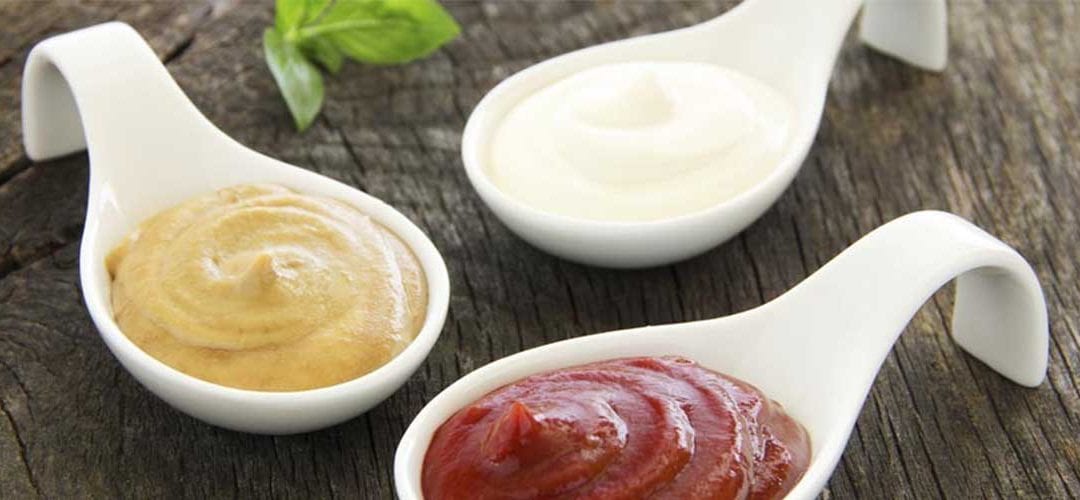
Credit: en.wikipedia.org
An emulsion is a dispersion of two liquids that do not mix with each other and there is plenty of these preparations in restaurants.
The emulsions contain a fat and water, and of course many other molecules.
If the fat is liquid at room temperature, it is commonly called oil.
Obviously, not all substances can mix with each other, in fact some of them remain completely separate.
For example, alcohol and water are mixed in any proportion, while fat and water form two different layers.
However, the molecules of an ingredient (dispersed phase) are able to go inside the other ingredient (continuous phase) if they are subjected to a strong stirring.
If the water is dispersed in fat, as in the butter or margarine, it is called « water in oil » emulsion.
On the contrary, if the oil molecules are dispersed in water, it is called « oil in water » emulsion, which are also the most common in the food industry.
However the main problem of the emulsions is to not be stable for a long time.
Therefore, we must prevent the separation of fat and water in order to use the emulsion.
For this reason, an emulsion is produced with the help of molecules with surfactant properties which stabilize the compound. They go between the fat molecules and water, preventing their separation.
What makes a stable emulsion?
For example lecithins, contained in egg yolk and in other foods, even if they do not form very stable emulsions.
It is very important not only to obtain the emulsion stability, but also and above all make it last for a long time (a very important aspect in the food industry, in which the stability must be guaranteed for many months).
Proteins are excellent emulsifiers and since they are edible, they are widely used in cooking.
They orient the hydrophobic areas towards the fat and hydrophilic areas towards the water.
The proteins (in addition to separating the droplets from the continuous phase) stabilize the emulsion by forming a layer that separates the droplets, preventing their aggregation.
Lastly, also the gelatin, the common « fish glue » is a good emulsifier.
The stability of emulsions
As we said before, the emulsions are very unstable.
They are very delicate structures and their stability can be affected by the pH, the temperature, the dissolved salts, the agitation and many other factors.
By increasing the temperature, the fats become more fluid and the elements within the emulsion will separate.
On the contrary, a cooling (but not freezing) can stabilize the emulsion.

Credit: www.cukrom.hu
An emulsion can be destabilized in many ways:
1) the dispersed phase goes to the surface (in the case of fresh milk, the fat droplets « crop up » and they are clearly visible)..
2) the droplets may join to each other and become bigger (coalescing effect).
The ingredients of an emulsion are essentially four: water, oil, an emulsifier and energy (usually mechanical energy).
But how much oil can we emulsify in a certain amount of water?
It is usually assumed that the oil droplets have all the same size.
If the droplets would stay in the densest way, their volume would be about 74% of the total (for example, this is the typical oil percentage in mayonnaise).
However, the molecules are not all equal and they are not rigid so the oil percentages can reach the 90%.
The emulsion is extremely unstable in this case.
Apéro pastis
Pastis mayonnaise pastis, breaded chicken sticks with Curly® peanut.
6 people
20 minutes preparation
5 minutes cooking
Ingredients of pastis mayonnaise:
– 1 egg yolk
– 10 cl of sunflower oil
– 1 spoon of wine vinegar
– 3 teaspoons of pastis
– salt and pepper
METHOD:
Mix the egg yolk and the wine vinegar and add salt and pepper.
Then add the oil, starting from small amounts and mix.
When the mayonnaise starts to thicken, add the remaining oil in larger quantities.
At the end add the pastis and stirr constantly.
Add salt and pepper to taste.
Ingredients of chicken sticks:
– 600 g of chicken cutlets
– 2 large peanut packs (type Curly®)
– 2 eggs
– 200 g of flour
– 4 spoons of sunflower oil
– salt and pepper
METHOD:
Pulverized the Curly peanuts (mixer or pestle) and add salt and pepper to taste.
Cut the chicken cutlets in sticks.
Then put the chicken sticks in the flour, in beaten egg and then in curly crumbs.
Cook them in a pan with oil over medium heat for 5 minutes, turning them occasionally.
Serve the Curly breaded chicken sticks with the pastis mayonnaise.
WARNING: the oil must be first added in small amounts to form an « oil in water » emulsion.
If the amount of incorporated oil at the beginning is excessive, you will obtain a « water in oil » emulsion and mayonnaise will not form.
VARIATIONS: you can replace the sunflower oil with any other fat liquid (olive oil, melted butter) and the yolk with any other food containing surfactant molecules (egg white, gelatin etc.).
You can adjust the amount of water you need, adding a flavoured liquid (beer, juice etc.).
Gazpacho Nord-Sud
Strawberry-pesto-cider Gazpacho, strawberry coulis.
6 people
10 minutes preparation
3 h in a refrigerator
Gazpacho ingredients
– 200 g of strawberries
– 20 g of pine nuts
– 6 large fresh basil leaves
– 40 g of madeleine (or alternatively other similar biscuits)
– 5 cl of olive oil
– 2 cl of vinegar cider
– 10 cl of sweet cider
METHOD:
Mix the chopped strawberries, pine nuts, basil leaves and the madeleine reduced in pieces, vinegar cider and olive oil in a salad bowl.
Cover and store in refrigerator for 3 hours.
Emulsify the mixture into the mixer, and then add the sweet cider.
Later, mix again with the mixer.
Ingredients for the strawberry coulis:
– 100 g of strawberries
– Extra-fine sugar
METHOD:
Put the strawberries in a blender and add the sugar to the coulis to taste.
Now, fill each tube with gazpacho soup and cover it with a layer of strawberry coulis.
Serve cool.
VARIATIONS:
Olive oil can be replaced with any other oil and vinegar cider with any other vinegar.
If you don’t have madeleine, or other biscuits, bread (cereals or figs) is an excellent substitute.
Beets and cucumbers (but not only) can be used in place of the strawberries.
The cider is not essential and even the normal water or fruit juice are perfect for this preparation.
In this way, you can create a great number of gazpacho (savoury or sugary), perfect for the aperitif or dessert!
Free your imagination to create amazing emulsions!
Get help from HotmixPRO, and discover how easy it is to realize tasty gazpacho without difficulty!








